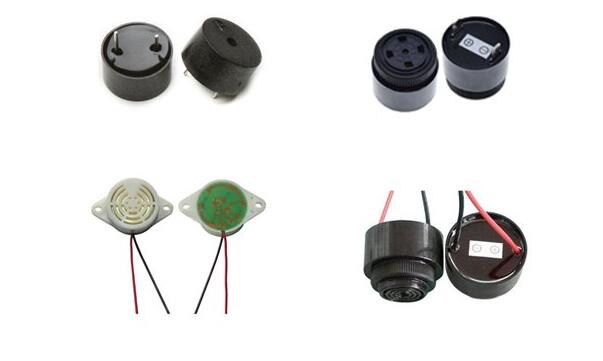How to distinguish magnetic buzzer and piezo buzzer
Buzzer is a common sounding component, which is widely used in various electronic products for alarms or reminders.
Buzzers are used in washing machines, microwave ovens, mixers, alarm clocks, remote control cars, calculators, etc. at home.There are two types of buzzers: piezo buzzer and magnetic buzzer .What is Piezo Buzzer?
The piezoelectric buzzer is made sound by piezo element, and the piezo element is made by piezoelectric ceramics.
Electrodes need to be plated on both sides of the piezoelectric buzzer for energization to apply alternating current to the piezo buzzer. After the driving signal is applied, the piezoelectric buzzer will expand and contract mechanically because of the piezoelectric effect, which can push the metal sheet attached to the piezoelectric ceramic sheet to vibrate and emit sound.
The piezoelectric buzzer needs to vibrate back and forth with the piezoelectric buzzer, so it needs to be driven by a square wave signal. Driving the piezoelectric buzzer requires a higher driving voltage to obtain a larger sound.
We can use NPN or PNP transistors to drive piezoelectric buzzers.
It is necessary to drive the piezoelectric buzzer with a 1/2 Duty PWM signal according to the resonant frequency of the piezoelectric buzzer, and an impedance matching resistor needs to be connected in parallel to the piezoelectric buzzer.
What is magnetic buzzer?
The electromagnetic buzzer uses the electromagnetic coil to drive the metal vibrating membrane to emit sound.
So the electromagnetic buzzer has coils and magnets inside.
When the power is turned on, the vibrating membrane is absorbed, and the metal vibrating membrane bounces back when the power is off.
The electromagnetic buzzer is best driven with a 1/2 square wave (1/4 duty) for better results. magnetic buzzer drive voltage is lower, but requires more current.
Similarly, we can use NPN or PNP transistors to drive the electromagnetic buzzer. Since there is a coil inside the electromagnetic buzzer, a freewheeling diode needs to be connected in parallel to the electromagnetic buzzer to avoid the reverse electromotive force generated by the coil from driving the transistor. breakdown.
It is also necessary to drive the electromagnetic buzzer with a PWM signal according to the resonant frequency of the electromagnetic buzzer, but it is best to drive the electromagnetic buzzer with a 1/4 Duty PWM signal.
For active electromagnetic buzzers, the most common is to directly drive a PWM signal. If the required current is larger, add a triode.
Active generally refers to a built-in oscillator circuit to generate a signal source, so as long as the power supply can be called, the frequency is single.
Passive needs to provide external oscillation signal such as PWM wave, the advantage is that the sound frequency is adjustable.
First of all, look at the driving power required by the piezoelectric buzzer. According to the size of the power, choose a simple transistor driving circuit or a logic gate driving circuit, an audio power amplifier circuit and other suitable circuits.
It should be noted that the piezoelectric buzzer is a capacitive load, and a resistive path needs to be added to a drive circuit suitable for a resistive load.
FBelec has been specializing in the production of buzzers for 20 years, hope our explanation will be helpful to you,any issues pls feel free to contact us!

- Home
- Product
- Acoustic Component
- Security & Alarm
- Sensor
- Piezo Ceramic
- Connector & Cable
- Fuse & Circuit Breaker
- Switch & Indicator
- Battery Holder & Connectors
- Motors & Fans & Heat Sink
- Power Supply
- Relay & Socket
- Ultrasonic Machine & Part
- LED & LED Display
- Wifi & Antennas
- Inductor & Choke
- Electricians Tools
- Electronic Beauty Instrument
- IC & Semiconductors
- Mould & Plastic Enclosure
- Smart Home
- Arduino & Robot
- Solution
- About
- News
- Contact
- Acoustic Component
- Piezo Ceramic Element
- Piezo Buzzer
- Magnetic Buzzer
- SMD Buzzer
- Piezo Transducer
- Magnetic Transducer
- Mechanical Buzzer
- Electret Condenser Microphone
- Loud Speaker
- Micro Speaker
- Mylar Speaker
- Ultrasonic Speaker
- Headphones & Earbuds & Headsets
- Bluetooth speaker
- Ceiling Speaker
- Garden Speaker
- Party Speaker
- Sound Button
- Sound Module
- Receiver
- Security & Alarm
- Sensor
- Piezo Ceramic
- Connector & Cable
- USB & Type C & HDMI Connector
- FFC / FPC / Wafer connector
- Card Socket
- Water Proof Connector
- Anderson Battery Connector
- Wire Harness
- Micro D Connector
- Coaxial Connectors
- New Energy Vehicle Charge Accessory
- Magnetic Power Connector
- Compact Splicing Connector
- Screw Nut & Spacer
- USB HUB & Type C Adapter Converter
- Splitter & DP HDMI
- Heat Shrink Tube
- USB & Type C & HDMI cable
- Pin Header Connector
- Automotive Connectors
- Ethernet Connectors
- More Products
- Fuse & Circuit Breaker
- Switch & Indicator
- Battery Holder & Connectors
- Motors & Fans & Heat Sink
- Power Supply
- Relay & Socket
- Ultrasonic Machine & Part
- LED & LED Display
- Wifi & Antennas
- Inductor & Choke
- Electricians Tools
- Electronic Beauty Instrument
- IC & Semiconductors
- Mould & Plastic Enclosure
- Smart Home
- Arduino & Robot


